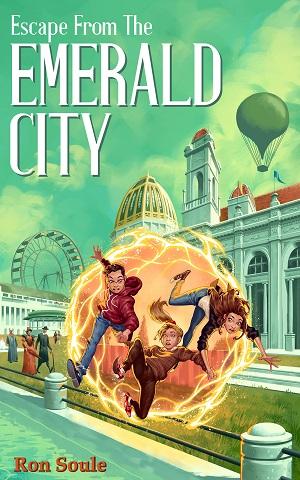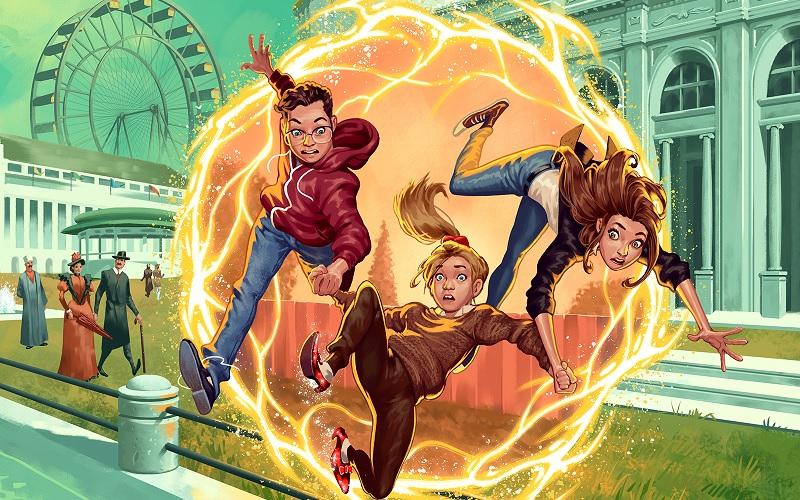
Escape from the Emerald City by Ron Soule. Independently published, 2023. 105 pages. Hardcover, $14.95. ISBN 9798395968029. Paperback, $7.95. ISBN 9798395968111.
In the growing library of “fairground fiction,” stories that involve historical figures offer a special treat to readers who enjoy imagining how famous (and soon-to-be-famous) people experienced the 1893 World’s Fair. A then-unknown traveling salesman from Chicago visited the fairgrounds on several occasions with his wife and four sons. Only a few years later he would burst onto the literary scene with such acclaimed children’s books such as Mother Goose in Prose (1897) and The Wonderful Wizard of Oz (1900).
What L. Frank Baum never wrote about was his visits to the World’s Columbian Exposition. Many decades later, his two oldest sons each wrote family histories about their time in Chicago that included a brief sketch about visiting the great Fair (at ages nine and three), though one has to wonder if they were recording their own memories or family stories they had heard. It is tempting—and quite reasonable—to see the imprint of the World’s Fair on Baum’s Oz novel, and this connection has, in recent decades, developed into an unquestioned fact. Did the White City of Chicago really inspire Baum’s conception of the Emerald City of Oz? We may never know. This missing chronicle of Baum’s time at the Exposition may be unfortunate for scholars and fans of his work, but it offers a rich opportunity for a novelist to craft a fictional account of Baum’s formative experience at the Fair. Ron Soule has cleverly done just that.
Did the White City of 1893 inspire the Emerald City of Oz?
After receiving a mysterious gift, Katie Sexton—with her brother Tristan and sister Destinee— travels from 2023 Texas to the 1893 World’s Fair in Chicago using a magical method familiar to any Oz fan. Upon landing in the fairgrounds and averting their first danger, the Sexton kids meet Mr. Baum, his wife Maud, and his four children: Frank Joslyn, Robert, Harry, and Kenneth. (Frank Jr., known by the nickname “Bunny” at home, is given the nickname “Joss” in this story.) The Sexton and Baum kids seem to accept the 130-year rift between them rather casually, though the story is sprinkled with occasional dialog pointing to anachronisms as they arise.
The adventure begins and (spoiler alert!) ends at the Electricity Building, as the Baums help the time-travelers escape from a crooked circus owner and his henchmen and ultimately find their way back (forward?) home. To assist with the latter task, Mr. Baum comes up with an ingenious idea of asking a certain Wizard for help.
Complementing this main adventure is the delightful story of Mr. Baum encountering a series of (imagined) inspirations for his future Oz tale sprinkled around the fairgrounds; he continuously jots down these ideas into a notebook. Some unfold naturally, as when he sees two boys in Hagenbeck’s Animal Arena teasing a timid animal (the future Cowardly Lion of Oz?) or when he circles a newspaper story about a tornado that picked up a house. In other instances, Katie takes an active role in feeding such inspirations to Mr. Baum, as when she points out the appearance of “a yellow brick road” in the Baum’s neighborhood. Just after that, she finally recognizes who her host is, exclaiming, “We ended up here because the Chicago World’s Fair is his Emerald City!” It certainly took her longer than readers will need to figure that out. Oz enthusiasts likely will pick up on Soule’s most subtle references, such as in a description of Edison’s electric “Tower of Light” glowing with red, blue, green, yellow, and purple lights.
The Edison Tower of Light in the General Electric exhibit in the Electricity Building. [Image from Bancroft, Hubert Howe The Book of the Fair. The Bancroft Company, 1893.]
One important Oz inspiration, which seems most historically authentic of all, is the effect when visitors wore colored sunglasses in the White City. When Katie slips on a pair of green spectacles, she exclaims “This is it. We’re in the Emerald City!” loud enough for the budding author to hear. Baum’s Emerald City in The Wonderful Wizard of Oz is, in fact, white and only appears green because everyone is required to wear green-colored glasses. Another scene describes an even more famous origin story—though one that Oz researchers have cast doubt on—that the name for Baum’s fairyland came from the label O–Z on a file cabinet.
Soule make an ingenious connection between a little-known sculpture titled The Sleep of the Flowers by Lorado Taft that adorned the Horticultural Building and Baum’s use of a poppy field as an obstacle in his Oz story. Whether real or imagined, each new revelation—the origins of Toto, Munchkins, and the Tin Woodman, to name a few others—should delight young readers.
Lorado Taft’s The Sleep of the Flowers [Image from Hitchcock, Ripley The Art of the World Illustrated in the Paintings, Statuary, and Architecture of the World’s Columbian Exposition, Volume II (D. Appleton, 1895).]
An interesting coincidence not pointed out in this story occurs when the Baums visit the Volcano of Kilauea Cyclorama on the Midway. The artist who created the enormous paintings for that attraction was Walter Burridge, who a few years later painted the backdrops for Baum’s hit musical extravaganza The Wizard of Oz, which premiered in Chicago in 1902.
One thrilling scene involves an ascent in the Captive Balloon ride on the Midway. The story is set in the last days of June, just before a powerful wind storm ripped the balloon from its moorings and tore it to pieces on July 9. Small changes to the chronology of the Exposition are inconsequential, such as having Thomas Edison present more than a month before he actually arrived on the fairgrounds until mid-August.
The Captive Balloon ride on the Midway Plaisance. [Image from an Underwood & Underwood stereoview card.]
A sticking point for some readers, perhaps, will be the changes to facts about Baum. In 1893, his family lived on Chicago’s West Side, while in this story their home is at 1667 Humboldt Boulevard. The family did not move to this North Side address until the summer of 1898 (and, even then, the street number was 68 until Chicago renumbered its streets in 1909). Having Maud Baum’s character describe Susan B. Anthony as the “best friend” of her mother, Matilda Joslyn Gage, also is sure to raise eyebrows, as these two suffragists had experienced a terrible falling out by 1893. Another head-scratcher is when Mr. Baum asks Katie if she has read his Father Goose (not published until 1899) or The Magical Monarch of Mo (not published under that title until 1903).
The blending of references to the 1939 MGM Wizard of Oz film (ruby slippers, a gingham dress, and “lions, and tigers, and bears, oh my!”) with those of Baum’s original Oz story may puzzle ardent Oz enthusiasts but may not bother most readers.
Soule has crafted a fast-paced adventure story, but one that can feel rushed. The action briefly touches upon many famous aspects of the Exposition (MacMonnies Fountain, the Street in Cairo and Ferris Wheel on the Midway, and the new “brownie” confection), as well as several obscure attractions (such as the Ostrich Farm and Hindoo Jugglers on the Midway, Josephine Cochrane’s dishwashing machine, and the Hub Gore Shoes “Uncle Sam” automaton). Unfortunately, characters and readers barely get to explore one fascinating site before dashing off to the next. The Baums and Sextons move from the German Village to the Turkish Village to the Java Village in just a half page of narrative. In other scenes, the actual ground these visitors cover in a short amount of time would have been exhausting, if not impossible.
Fast but fun, this adventure story offers inquisitive children interested in Gilded Age American history in general or the Columbian Exposition in particular the opportunity to explore the fairgrounds, broadly if not deeply. Escape from the Emerald City also provides an interesting historical complement to The Wonderful Wizard of Oz. Its pages sparkle with the beauty and power of a creative imagination, and the gorgeous wrap-around cover art by George Doutsiopoulos is lively and enticing. Although the story of how the Sexton kids visited the Fair as Baum crafted his most famous tale appears to have come to an end in this volume, let’s hope that Mr. Soule treats readers to another historical novel set at the Exposition.

